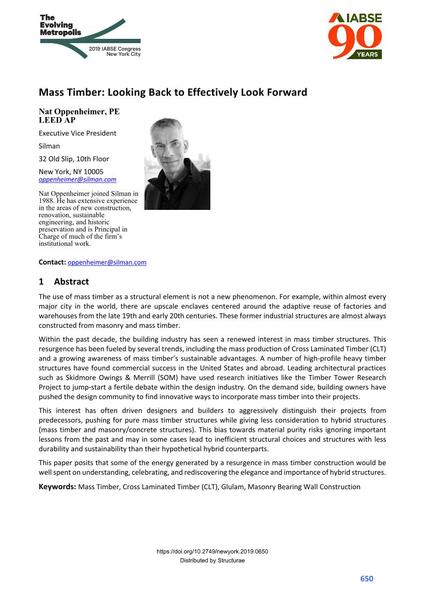Mass Timber: Looking Back to Effectively Look Forward

|
|
|||||||||||
Bibliografische Angaben
| Autor(en): |
Nat Oppenheimer
(Silman)
|
||||
|---|---|---|---|---|---|
| Medium: | Tagungsbeitrag | ||||
| Sprache(n): | Englisch | ||||
| Tagung: | IABSE Congress: The Evolving Metropolis, New York, NY, USA, 4-6 September 2019 | ||||
| Veröffentlicht in: | The Evolving Metropolis | ||||
|
|||||
| Seite(n): | 650-654 | ||||
| Anzahl der Seiten (im PDF): | 5 | ||||
| DOI: | 10.2749/newyork.2019.0650 | ||||
| Abstrakt: |
The use of mass timber as a structural element is not a new phenomenon. For example, within almost every major city in the world, there are upscale enclaves centered around the adaptive reuse of factories and warehouses from the late 19th and early 20th centuries. These former industrial structures are almost always constructed from masonry and mass timber. Within the past decade, the building industry has seen a renewed interest in mass timber structures. This resurgence has been fueled by several trends, including the mass production of Cross Laminated Timber (CLT) and a growing awareness of mass timber’s sustainable advantages. A number of high-profile heavy timber structures have found commercial success in the United States and abroad. Leading architectural practices such as Skidmore Owings & Merrill (SOM) have used research initiatives like the Timber Tower Research Project to jump-start a fertile debate within the design industry. On the demand side, building owners have pushed the design community to find innovative ways to incorporate mass timber into their projects. This interest has often driven designers and builders to aggressively distinguish their projects from predecessors, pushing for pure mass timber structures while giving less consideration to hybrid structures (mass timber and masonry/concrete structures). This bias towards material purity risks ignoring important lessons from the past and may in some cases lead to inefficient structural choices and structures with less durability and sustainability than their hypothetical hybrid counterparts. This paper posits that some of the energy generated by a resurgence in mass timber construction would be well spent on understanding, celebrating, and rediscovering the elegance and importance of hybrid structures. |
||||
